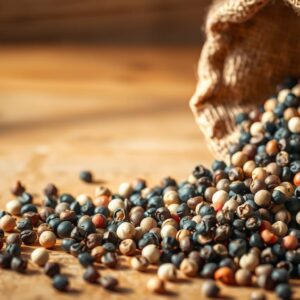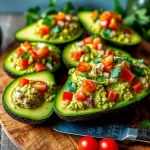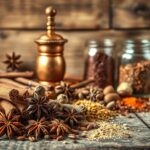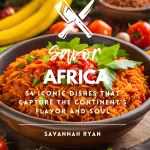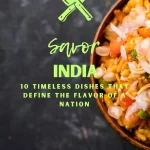Bread has been with us since ancient times. It started with early farmers who grew grains. These grains made nomadic tribes stay in one place.
In ancient Egypt, bread was so important that they put it in tombs. Roman soldiers ate hardtack on their journeys. In medieval times, bread brought people together, from peasants to kings.
Today, baking connects us to our past. With best cookbook recipes, we can make bread like ancient Egyptians or German stollen. These dishes tell a story of survival, innovation, and community.
When you knead dough, you connect with centuries of tradition. Whether it’s sourdough or gluten-free, each loaf has a story. Your kitchen becomes a classroom where history meets modern recipes.
Baking bread is a timeless craft. From ancient Egypt to your oven, it’s a journey of bread’s role in our shared history. Every loaf tells a part of our story.
The Dawn of Breadmaking: How Ancient Civilizations Discovered Leavening
Thousands of years ago, our ancestors made flatbreads from wild grains and hot stones. These early steps set the stage for bread’s journey. They mixed flour and water, then cooked it on heated rocks—a method from 30,000 years ago.
By 14,500 BCE, the Natufians in Jordan made perfect flatbreads. They left their mark in archaeological sites.
Leavened bread came from accidental discoveries. Wild yeast spores made dough rise, a breakthrough in Mesopotamia around 6000 BCE. This created lighter, airy loaves like injera and sourdough pancakes.
Over time, cultures improved their techniques. They used ale instead of water to make bread rise, as seen in ancient Egypt by 3000 BCE.
Today, you can try these ancient methods with easy cookbook recipes. Mix flour and water, let it sit to catch wild yeast—no special tools needed. Our homemade cookbook recipes will guide you, using ingredients from Mesopotamia. These recipes show how patience and simple ingredients make bread with depth, just like our ancestors.
Modern science backs up what early bakers knew: longer fermentation breaks down flavors and nutrients. Whether making flatbread or trying wild yeast, these methods connect you to a tradition over 20,000 years old. Every loaf you bake is a link between ancient ingenuity and your kitchen’s creativity.
Bread as the Foundation of Human Civilization
Bread was more than just food; it was the foundation of society. About 10,000 years ago, farming wheat and rye in ancient Turkey changed nomadic tribes into settled communities. This simple food item was easy to store, helped growing populations, and became key in trade and culture.
Today, home cooks can connect with this past through popular cookbook recipes. These recipes bring back ancient ways of making bread. Healthy recipes often use whole grains like einkorn, just like early farmers did.
Sally Lunn bread, from the 17th century, is still made today. It uses cream and yeast, and is baked at Virginia’s Raleigh Tavern Bakery. Its recipe needs 4 cups of flour and a 45-minute bake at 350°F, blending old traditions with new kitchen tools.
Baking bread today is a way to honor our history and meet modern needs. These recipes are not just about flavor; they connect us to our ancestors’ creativity.
Sacred Loaves: Spiritual and Religious Significance of Bread Throughout History
Bread has played a big role in faith beyond just eating it. It has been used in temples and during sacred rituals. Our cookbook recipes collection brings these traditions into your kitchen, making them easy to follow.
- Israelite temple loaves weighed nearly five pounds each, offering tangible reminders of God’s presence in worship.
- Christian communion wafers and Jewish Challah carry centuries of symbolism, now simplified in our cookbook recipes for beginners.
- Hindu prasad and Orthodox prosphora reflect spiritual unity, with modern adaptations in our step-by-step guides.
Discover the Last Supper’s bread, Passover matzah, and Day of the Dead pan de muerto in our guides. Each recipe comes with historical context and blessings. For example, the Shabbat Challah’s braided strands symbolize the twelve tribes of Israel.
Our book, honored with a Religion Category Gold Medal and featured on @lechlechallah, connects faith and practice. Learn to make prosphora’s round form for Orthodox Eucharist or Easter hot cross buns with cinnamon crosses. Each entry combines theological insights with practical tips, making ancient rituals easy to follow.
Whether kneading Challah dough or baking communion bread, these recipes honor tradition. They also empower home cooks. Our guides make sure even beginners can create sacred loaves, blending reverence with everyday cooking.
The Geography of Grain: How Different Regions Shaped Bread Varieties
Every region’s bread tells a story of its land and climate. In Morocco, where droughts are common, bread like msemen and khobz rely on hard wheat. This wheat thrives in arid soils. By 2022, Morocco imported 6.5 million tons of wheat, yet local traditions persist.
A 2023 study found Moroccan sourdough starters use unique ingredients like dates and chickpeas. This shows how environment shapes flavor.
Northern Europe’s cold climates birthed rye bread. Its resilience in poor soils made it a staple. Finland’s 2017 referendum named rye bread their national food, a testament to its cultural roots.
France’s wheat-rich fields fueled baguettes, while Japan’s humid climate inspired sticky mochi-like batters for mantou buns.
Today, home cooks can explore these traditions throughdelicious cookbook recipesthat highlight regional techniques. Try quick cookbook recipes like Moroccan msemen or Finnish rye sourdough, adjusting for modern kitchens. Whether using a Dutch oven or improvising with local flours, these methods connect us to centuries of culinary adaptation.
From the 18th-century potato bread of America to Middle Eastern pita, each recipe shares a story. Our guides simplify ancient methods, so even busy kitchens can master global breads. Experiment with rye’s nutty depth or Morocco’s spiced loaves—your next loaf could be a journey across continents.
Bread and Social Class: From Peasant Staples to Royal Indulgences
For centuries, bread showed who was in charge. Peasants ate dense loaves made from rye, barley, and oats. These were filling and cheap.
The rich, on the other hand, wanted soft, white bread made from wheat. It was a sign of wealth. Laws in places like England even made sure only certain breads were for certain people.
After the Black Death, things changed. Peasants got to eat more meat and different grains. The rich used spices and sugar to show off their status.
By the 1600s, sugar was a sign of nobility, replacing honey in fancy kitchens. Today, our best cookbook recipes mix old and new. They include peasant breads and fancy techniques, connecting past and present.
Now, healthy recipes celebrate what was once simple. Whole-grain loaves, once for workers, are now full of fiber. Old methods like sourdough are now seen as high-quality.
Try making dense rye bread or soft white loaves. Each recipe tells a story of power and everyday life. Through these recipes, you can taste history.
Essential Cookbook Recipes for Traditional Bread Varieties
Our collection of cookbook recipes brings centuries of tradition to your kitchen. Start with Mediterranean classics like Italian ciabatta or Greek pita. These can be made with everyday ingredients. Even easy cookbook recipes from “Savor the World Global Bites” show that cultural staples like Turkish pide or French baguettes need no special tools.
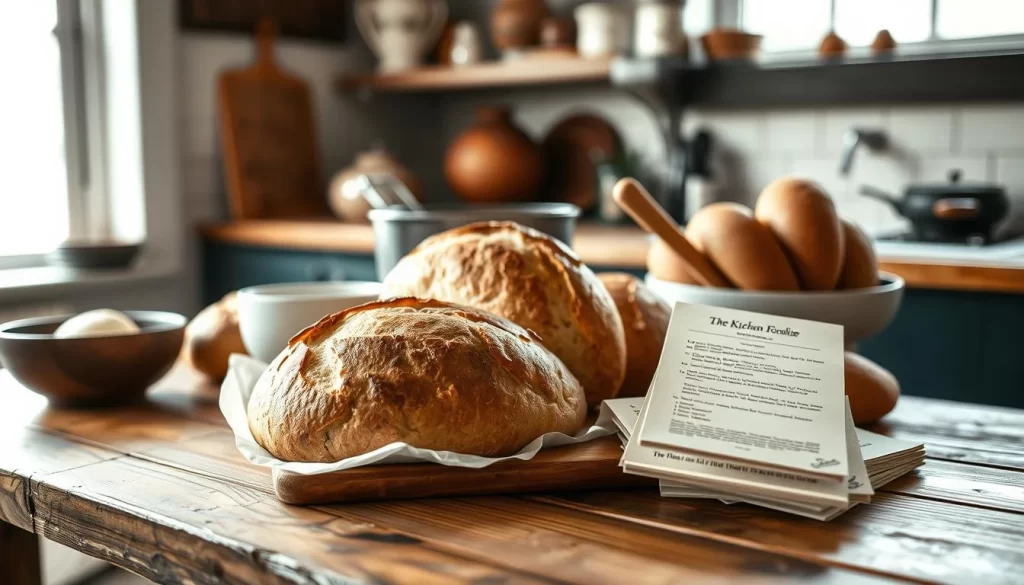
Our selection includes 39 recipes, with each slice averaging 180 calories. Options range from Mom’s Italian Bread at 97 calories to Honey Cornbread at 318. For quick bakers, Garlic-Cheese Crescent Rolls are ready in 20 minutes. On the other hand, rustic loaves like Pain de Campagne take 1.5 hours.
Ken Forkish’s “Flour Water Salt Yeast” makes artisan methods easy with instant yeast. “Tartine Bread” dives deep into sourdough science with 38 pages. Whether baking for a family meal or exploring cultures, these guides offer clear steps.
Shirley Corriher’s “BakeWise” explains the science behind rising dough. “Mother Grains” highlights eight heritage flours. All recipes include tips like scoring dough and oven temperatures for consistent results.
Explore these proven cookbook recipes to connect with global traditions. With 6 grams of fat and 24 carbs per serving, these loaves are nutritious and flavorful. Join thousands who’ve mastered techniques from “Kitchen Projects” or King Arthur’s Vermont school. Every recipe here bridges history and home kitchens, proving that traditional breads are for everyone.
The Industrial Revolution and the Mechanization of Breadmaking
The Industrial Revolution changed bread from a hard craft to a mass product. By the 1850s, Louis Pasteur found yeast for making bread easier. Steam machines cut down making time by more than 90%.
Companies like Wonder Bread started in 1921, focusing on fast production. But this speed lost the bread’s rich taste and nutrients. They used simple yeast and fine flours instead.
Now, many popular cookbook recipes go back to old ways. Our homemade cookbook recipes show you how to make sourdoughs and grain loaves. These use slow fermentation for better taste and health.
Try our naturally leavened country loaf or stone-ground rye bread. These methods bring back traditions lost to machines.
Look at popular cookbook recipes that mix old and new. These homemade cookbook recipes show you can get bread’s rich taste back. Even busy cooks can make loaves full of heritage flavors.
Join us in bringing back bread’s heritage. Let’s make bread with love and care, one dough at a time.
Artisanal Revival: The Return to Traditional Breadmaking Methods
Today, we see a mix of old and new in breadmaking. Delicious cookbook recipes are now easy to find. Chad Robertson and Nancy Silverton have made slow fermentation and hand-shaping popular again. They show that these methods create better-tasting bread.
Now, home cooks can try cookbook recipes for beginners that make ancient techniques simple. This has made breadmaking fun and accessible for everyone.
Modern bakers use heritage grains and new science to make bread. They can make sourdough in just 3 days. This shows that even busy people can make great bread.
More people choose artisanal bread for its taste. Also, more bakeries now focus on making handcrafted loaves.
Beginners can start with easy recipes like no-knead focaccia or multigrain sourdough. Check out our guides or family baking traditions for more. These resources will help you make delicious bread.
Try using 12-14% protein bread flour or Dutch oven baking. Each loaf connects us to our past. It shows how breadmaking has evolved while staying true to its roots.
Bread and Health: Nutritional Perspectives Through the Ages
Over time, our view of bread’s role in health has changed. Ancient Greeks saw bread as a source of nourishment. In the Middle Ages, healers believed different breads could balance body humors. Today, we understand bread’s nutritional value—carbs, fiber, and vitamins—thanks to science.
In the Eastern Coachella Valley, diabetes is a big problem. Our community project created a cookbook with healthy cookbook recipes for Latinx families. These recipes use whole grains and traditional methods to balance taste with nutrition.
Our quick cookbook recipes are fast but still nutritious. They include the right amounts of whole wheat flour and water. Our study showed that using these recipes can improve diabetes knowledge.
We want to help you make better bread choices. Whether you bake whole grain loaves or adapt classic recipes, every choice helps. Try our methods and recipes to make bread that’s good for you and your culture. Your kitchen can be a place where tradition and wellness meet, one loaf at a time.
Modern Bread Innovations: Fusion Loaves and Contemporary Techniques
Modern breadmaking is all about mixing old traditions with new ideas. Today’s bakers blend global flavors with modern techniques. They create loaves that combine ancient grains with fresh methods.
Imagine Japanese milk bread with a European twist, or Middle Eastern spices in French dough. They also turn heritage grains into new textures. These innovations respect tradition while exploring new horizons.
Our cookbook recipes showcase bold new methods from top bakers. Chad Robertson’s sourdough and Nancy Silverton’s grape-fed starter are now easy to make at home. Richard Bertinet’s slap-and-fold technique is also explained in simple steps.
These recipes reveal the science behind making bread. They turn complex processes into easy steps. You’ll learn about fermentation and gluten development.
Find recipes for bold flavors like chocolate cherry sourdough and turmeric-ginger loaves. Sprouted quinoa breads are also included. These recipes explain how to control fermentation and adjust hydration levels for better taste.
Our collection includes award-winning recipes from Chad’s Tartine Bakery and Nancy’s La Brea Bakery. You’ll also learn innovative dough-handling techniques.
We’ve organized these recipes to help you build your skills. Start with the basics and then move on to more advanced methods. Whether you’re working with Chad’s 82% hydration dough or Nancy’s natural starter, each step makes innovation easier to understand.
These recipes reflect the latest trends in breadmaking. They stay true to bread’s timeless principles. You’ll find recipes from top bakers like Chad and Richard, all adapted for home ovens.
These methods use precision tools like proofing boxes or digital scales. But they also work with basic equipment. Every recipe balances tradition and modernity, showing that innovation doesn’t mean losing the essence of bread.
From History to Your Kitchen: Becoming Part of Bread’s Continuing Story
Bread’s story is far from over. It’s ready for your touch. Begin with cookbook recipes that mix old traditions with new ideas. Try sourdough from Tartine Bread or quick methods from Holiday and Celebration Bread. These recipes are more than just steps; they connect us to the past.
Play with spices like cinnamon or cumin, as shown in spice blends. This makes your bread truly yours. Whether you follow Salt, Fat, Acid, Heat or make American Cookery recipes, every loaf you make adds a new page to the story.
Join bread-making groups or share your bread with friends and family. This simple act reminds us of how communities came together over food. Even small choices, like using whole grains or local ingredients, keep bread’s tale alive. Start with a simple dough, let it rise, and feel the bond with bakers through time.
Source Links
- https://food2mouth.com/decoding-bread-types-history/
- https://www.historicalcookingproject.com/2014/12/guest-post-ancient-egyptian-bread-by.html
- https://en.wikipedia.org/wiki/Bread
- https://www.foodtimeline.org/foodbreads.html
- https://livesandlegaciesblog.org/2024/06/26/bread-talk-a-slice-of-history-in-colonial-america/
- https://www.seleneriverpress.com/breads-of-the-world-the-sally-lunn-an-american-colonial-bread/
- https://www.crosswalk.com/faith/bible-study/what-is-the-significance-of-bread-in-the-bible.html
- https://www.ccarpress.org/shopping_product_detail.asp?pid=50599
- https://www.theperfectloaf.com/the-breads-of-morocco/
- https://www.theperfectloaf.com/the-whys-of-ryes/
- https://www.tastingtable.com/926363/types-of-bread-explained/
- https://digitalcommons.liberty.edu/cgi/viewcontent.cgi?article=1176&context=masters
- https://www.academia.edu/224003/Food_Drink_and_Identity_Cooking_Eating_and_Drinking_in_Europe_since_the_Middle_Ages
- https://www.foodtimeline.org/foodfaq6.html
- https://www.tasteofhome.com/collection/recipes-for-homemade-bread/?srsltid=AfmBOopGTYNCmYopxl1nH-D_EA0v3sH36RtfTNxxc67Q3Hb2WHezaOZ-
- https://www.seriouseats.com/best-baking-cookbooks-8669768
- https://food52.com/blog/25281-big-community-book-off-bread-contest-winner?srsltid=AfmBOorBAyeXjef2Hb1JICve1ItyCXSi3y_37LI7Ud4VjnUfF6dDlEvN
- https://www.academia.edu/448255/The_Bread_Making_Machine_Tacit_Knowledge_and_Two_Types_of_Action
- https://gastropod.com/transcript-white-vs-wheat-the-food-fight-of-the-centuries/
- https://www.bbc.co.uk/blogs/food/2011/03/great-british-revival-the-lost.shtml
- https://247broadstreet.com/Artisanal-Bread-The-Art-of-Crafting-Perfect-Loaves-at-Home.html
- https://www.materfamiliaswrites.com/2018/04/bread-making-old-school-artisan-and.html
- https://bmcpublichealth.biomedcentral.com/articles/10.1186/s12889-022-14804-3
- https://britishfoodhistory.com/2022/11/17/favourite-cook-books-no-5-english-bread-yeast-cookery-by-elizabeth-david/
- https://food52.com/recipes/83036-overnight-40-percent-whole-wheat-bread-recipe?srsltid=AfmBOopIYMLF2-UMolvE-kxzBP4n6SDvcwL-c1y400AmgSm1ZICHE0G4
- https://www.bookey.app/book/bread
- https://cookswithoutborders.com/new-story/category/Cookbooks We Love
- https://www.eatyourbooks.com/blog/2017/12/2/the-best-cookbooks-of-2017
- https://www.bonappetit.com/story/the-23-best-cookbooks-fall-2023?srsltid=AfmBOoqJK8o9e05bfDeoZcDCcT46Z31crtV1hneCyvLEWpW2U6nkiNVe
- https://en.julskitchen.com/other/books/cookbooks-that-work
- https://www.nationalbreadmuseum.org/cookbook-culture/




